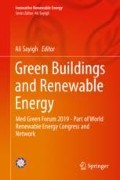Abstract
Urban air pollution caused by transport, traffic congestion, and high energy use is considered one of the major challenges in megacities. This paper presents a study on the effect of using nanocoating on the buildings’ facades to improve air quality in cities. It also highlights the types and uses of nanocoating in various countries through a comparative analysis of global case studies. The objective of this work focuses on titanium dioxide as a self-cleaning photo-catalytic to mitigate pollution and improve indoor air quality. The methodology depends on inductive and analytical approaches: the first part includes a review on the nanotechnology and nanocoating, whereas the analytical part encompasses an assessment of global models for nanotechnology. The study analysed different buildings around the world that applied different types of Nanocoatings. The review of these buildings were divided according to their types of nanocoating, the country where most common types of buildings used and the country that has similar matching to Egypt’s climatic conditions. By analysing each building facades, it was helpful to extract the nanotechnologies, especially self-cleaning (photo-catalytic) that mitigate air pollution. In addition, assessments of the percentage of pollutants worldwide to identify the most important pollutants that are classified as top contaminants threatening human health, if the concentration in the internal spaces exceeds the limits recommended globally were highlighted. Finally, a review of the report of Ministry Environment, Egypt, and the maximum limits of pollutants at the global scale was also conducted, which led to the extraction of requirements to reduce contaminants in the internal spaces of buildings using titanium dioxide as self-cleaning (photo-catalytic). Results show the potential of titanium dioxide as a self-cleaning (photo-catalytic) to mitigate the level of pollution to enhance livability in cities.
Access this chapter
Tax calculation will be finalised at checkout
Purchases are for personal use only
References
Ministry of Environment, Air Quality in Egypt—December 2017, National Network for Monitoring Ambient Air Pollutants. (2017). Retrieved March 15, 2019, from http://www.eeaa.gov.eg/enus/topics/air/airquality/airqualityreports.aspx/
Thakur, I. S. (1998). Environment and biotechnology (p. 69). New Delhi: International Pvt. Ltd..
Mohamed, E. F. (2017). Nanotechnology: Future of environmental air pollution control. Environmental Management and Sustainable Development, 6, 429.
Caillol, S. (2011). Fighting global warming: the potential of photocatalysis against CO2, CH4, N2O, CFCs, tropospheric O3, BC and other major contributors to climate change. Journal of Photochemistry and Photobiology C Photochemistry Reviews, 12(1), 1–19.
Boostani, H., & Modirrousta, S. (2016). Review of Nanocoatings for building applications. Procedia Engineering, 145, 1541.
Leydecker, S. (2008). Nano materials: In architecture, interior architecture and design (p. 58). Basel: Birkhauser Verlag AG.
Scalisi, F. (2017). Nano-materials for architecture. Journal of Civil Engineering and Architecture, 11, 1061.
Inas, H. I. A. (2014). Nano materials and their applications in interior design. American International Journal of Research in Humanities, Arts and Social Sciences, 7, 16.
Beeldens, A. (2006). An environmental friendly solution for air purification and self-cleaning effect: The application of TiO2 as photocatalyst in concrete. Proceedings of transport research arena Europe–TRA, Göteborg, Sweden.
The World Health Organization. (2016). WHO’s urban ambient air pollution database-update 2016, Geneva: Public Health, Social and Environmental Determinantes of Health Department. Retrieved March 10, 2019, from https://www.who.int/phe/health_topics/outdoorair/databases/cities/en/
Future markets, nanocoatings—Construction & exterior protection (3rd ed.) (2014). Retrieved February 22, 2019, from https://www.futuremarketsinc.com/nanocoatings-buildings/
World Health Organization. (2006). Air quality guidelines: Global update 2005: Particulate matter, ozone, nitrogen dioxide, and sulfur dioxide (p. 217). Geneva: World Health Organization.
Leung, D. Y. C. (2015). Outdoor-indoor air pollution in urban environment: Challenges and opportunity. Frontiers in Environmental Science, 2(69), 2–4.
Petty, S. (2014). Summary of ASHRAE’s position on carbon dioxide (CO2) levels in spaces (pp. 2–4). Energy & Environmental Solutions, Inc.
Huang, Y., Ho, S., Lu, Y., Niu, R., Xu, L., Cao, J., & Lee, S. (2016). Removal of indoor volatile organic compounds via photocatalytic oxidation: a short review and prospect. Molecules, 21, 56.
Andaloro, A., Mazzucchelli, E. S., Lucchini, A., & Pedeferri, M. P. (2016). Photocatalytic self-cleaning coatings for building facade maintenance. Performance analysis through a case study application. Journal of Facade Design and Engineering, 4, 115.
Pavilion-expo-2015. Retrieved April 10, 2019, from http://www.nemesistudio.it/en/projects/type/culture/item/714-italy-pavilion-expo-2015,-milan.html/
Prosolve370e. (2019). Retrieved March 10, 2019, from http://www.prosolve370e.com/
Awadalla, A., Zain, M. F. M., Kadhum, A. A. H., & Abdalla, Z. (2011). Titanium dioxide as photocatalyses to create self cleaning concrete and improve indoor air quality. International Journal of Physical Sciences, 6, 6767.
Boonen, E., & Beeldens, A. (2014). Recent photocatalytic applications for air purification in Belgium. Coatings, 4, 553.
Author information
Authors and Affiliations
Editor information
Editors and Affiliations
Rights and permissions
Copyright information
© 2020 Springer Nature Switzerland AG
About this chapter
Cite this chapter
Elhennawi, E.M., Aboulnaga, M.M. (2020). Impacts of Exploiting Nanocoating on Buildings’ Façades to Improve Air Quality in Megacities, Mitigate Climate Change and Attain Livability. In: Sayigh, A. (eds) Green Buildings and Renewable Energy. Innovative Renewable Energy. Springer, Cham. https://doi.org/10.1007/978-3-030-30841-4_21
Download citation
DOI: https://doi.org/10.1007/978-3-030-30841-4_21
Published:
Publisher Name: Springer, Cham
Print ISBN: 978-3-030-30840-7
Online ISBN: 978-3-030-30841-4
eBook Packages: EnergyEnergy (R0)

